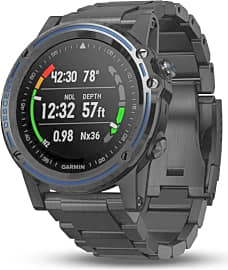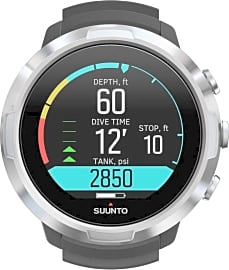The 10 Best Dive Computers

This wiki has been updated 38 times since it was first published in January of 2016. Scuba diving is one of the most enjoyable activities. What beats floating around among colorful fish and reef formations? But if you want to ensure your safety, or have difficulty keeping up with your dive logs manually, try one of these computers, some of which can do all the work for you. We've included both console and watch-style models, ranked by functionality, legibility, and battery life. When users buy our independently chosen editorial picks, we may earn commissions to help fund the Wiki.
Editor's Notes
December 30, 2019:
It's fairly obvious that the dive computer market has been significantly influenced by the continued growth of the smartwatch sector, especially with the kind of brand crossover you'll see from companies like Garmin and Suunto, who both make exceptional dive computers and smartwatches alike. Nowhere is this more apparent than in the latest generation of displays, which use AMOLED and TFT technology to provide users with clean, legible, full-color readouts of everything from dive time to air pressure. The Garmin Descent Mk1, in particular, utilizes that company's history developing GPS and GLONASS devices to offer divers color maps of location data that other computers lack. Unfortunately, there's no air integration on this model, so it's not for everybody.
We also saw a lot of compelling upgrades from Shearwater Research, Aqua Lung, and others, most of which added Bluetooth connectivity to their previous models to make dive logging to smartphone apps or PCs that much easier. It should be noted, however, that not all of these apps are created equal, with the Scubapro G2 being particularly hampered by underperforming software.
Underwater Safety
For a diver, an inert gas is part of the breathing mixture that is not metabolically active.
Exploring under the water can be a fascinating adventure and experience to behold. Descending into the depths of the unknown gives you a thrill, as you never know what you're going to see or find. Perhaps you have aspirations to find buried treasure or you're simply enamored with the opportunity to study underwater life. Whatever the reasons, you're going to need some type of monitor to ensure that your trip is as safe as possible, so that you avoid getting lost or experiencing decompression sickness when you decide to surface. While it's possible to dive without a dive computer, this little device will provide you added assurance for your safety and you'll be glad for having made the investment.
A dive computer is a small, watertight, battery-operated device housed in a pressure-resistant case and sometimes worn around the wrist (like a watch). The computer is designed to measure the time, depth, and ambient pressure of a deep dive under the water. In so doing, the computer ensures that a safe ascent profile can be calculated and conveniently displayed back to the diver in order to avoid complications when surfacing. In other words, once a diver has spent a certain amount of time at a particular depth, after which a direct ascent (without stopping) would be unsafe or inadvisable, it is the dive computer's job to calculate an algorithm (a self-contained and step-by-step set of operations to be performed) that is based on the surrounding water pressure and time input to estimate when a no-stop ascent is no longer possible.
Part of the calculation for this algorithm involves the measurement of inert gases that have dissolved inside a diver's tissues at a given point. An inert gas is defined as one that does not go through a chemical reaction under particular conditions. For a diver, an inert gas is part of the breathing mixture that is not metabolically active. Once the dive computer has calculated this algorithm, it then estimates which decompression stops will need to be made by the diver during his ascent, at particular altitudes, and for how long. This process minimizes the chances for decompression sickness.
So what types of information can a dive computer display? Most dive computers feature liquid crystal displays for easy viewing in the water. Firstly and most important is the no stop time, which is displayed as the amount of time that a diver can remain at his current depth without the need to make decompression stops on the way up to the surface. The computer will also display the current depth and the total elapsed time for the dive. Some dive computers can also display total ascent times and the temperature of the surrounding water, and they have audible alerts when a diver is ascending too quickly or when a decompression stop has been missed.
A Brief History Of The Dive Computer
Up until the early 1980s, recreational diving was learned by leveraging United States Navy diving tables. Because these tables were not based on multi-level diving profiles, algorithms were produced to account for changes in nitrogen uptake when a diver's depth was constantly changing. These algorithms were not computer-accessible until the invention of the microchip.
Around the same time, Orca Industries released the Orca Edge, which became the first commercially available dive computer.
In 1983, Austrian biologist Hans Haas innovated the first decompression diving computer called the DecoBrain, which was capable of displaying the same information that most modern dive computers display today. Around the same time, Orca Industries released the Orca Edge, which became the first commercially available dive computer. Rather than showing a decompression plan, the Orca Edge would display a safe-ascent depth instead.
The problem with this design was that the diver didn't always know how long he would have to decompress at a particular depth. Orca Industries continued refining its design with the Skinny-dipper in 1987, which was capable of running calculations for repetitive diving, followed by the Delphi in 1989 for calculating altitude.
In 2001, the US Navy approved the use of Cochran NAVY decompression computer, which made use of the Thalmann algorithm for Special Warfare operations. Developed by Captain Edward D. Thalmann, the Thalmann algorithm produces a decompression schedule for divers based on the use of the Mk15 rebreather.
By 2008, the release of the Underwater Digital Interface combined the functionality of two-way digital messaging, SOS and homing capabilities, and a 3D digital compass into a single dive computer.
Do Your Research And Keep Your Options Open
The best dive computer for you is the one that makes you feel the most confident in your ability to stay informed about your underwater circumstances and to keep yourself safe before, during, and long after you've surfaced from a dive. One should take time and research the features they would most like to have on the device.
If you plan to dive often, adequate memory storage is also important so that you can maintain an accurate history of your dives.
It goes without saying that a dive computer should be durable and easy to read. As a diver will need to be able to find his or her way back to their boat, finding one with an integrated compass will definitely come in handy, as it can supplement the need for a separate compass and it will also function accurately without having to be held level.
One must also ensure that their dive computer has a reliable depth gauge that will accurately record various depths as well as how much time has been spent at those depths. This will minimize the difficulty with decompression. If you plan to dive often, adequate memory storage is also important so that you can maintain an accurate history of your dives. The most cutting-edge dive computers can maintain a memory for up to ten dives.















